My Billion Dollar Mistake
Back in 2008, I co-founded KISSmetrics, an analytics company.
There were so many times when I thought about giving up during the early days. Over and over again, I felt like we were doing it all wrong. Making guesses about the problems people had. Building to solve problems we had imagined.
We were searching in the dark to solve painful problems. We had a clear vision, but our execution was flawed.
All we knew was that we wanted to reinvent the analytics market.
Our first attempt was an analytics platform for Facebook Application Developers because at the time they didn’t have any analytics solutions that worked for their needs. They were building their own analytics systems internally.
The people we created the product for – Facebook Application developers – loved it! Except they couldn’t pay us.
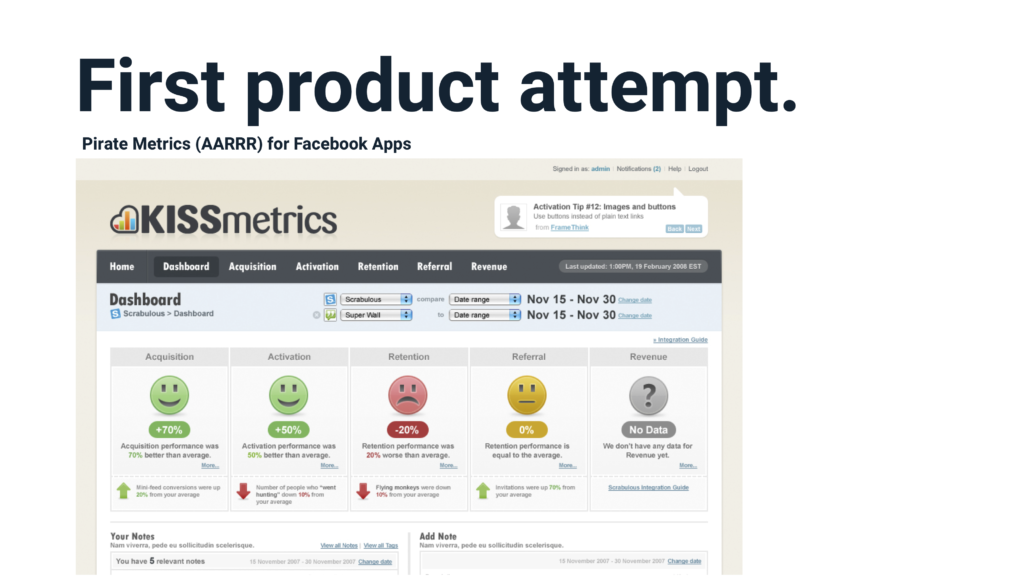
After building a product for customers that couldn’t pay for it, we decided to target anyone and everyone with an online business.
Our second attempt was a business intelligence tool that let companies of all types and sizes create dashboards for their key metrics. It let people track whatever they wanted to and customize how they looked at the data.
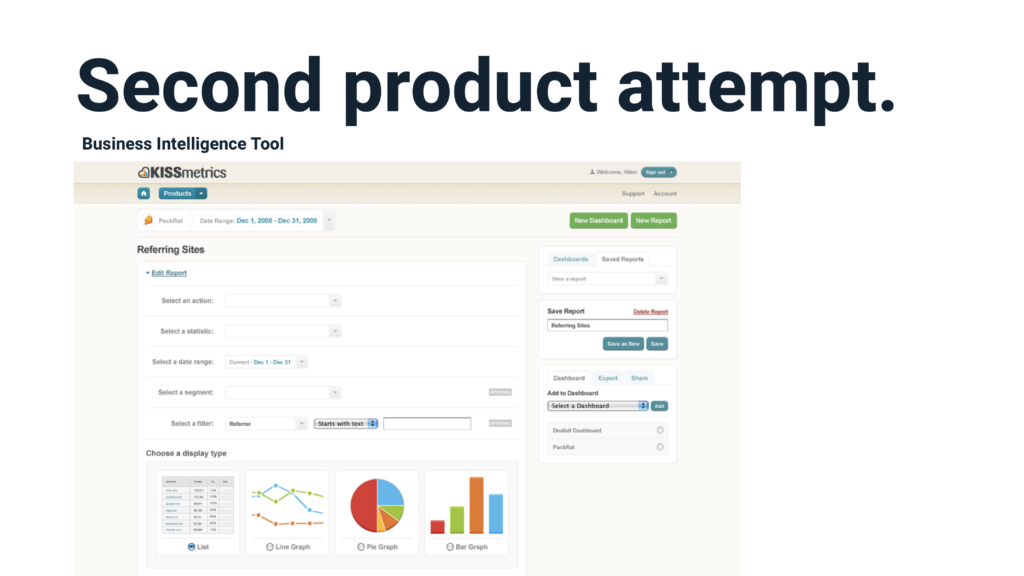
When we launched the second version, we found that users felt our product required too much customization. They weren’t interested in spending the time to configure the product. We learned that they wanted to do the least amount of work possible to get value. Our business would have to be consulting and services heavy in order to make this second version of the product a hit.
Despite our attempts at building two different products, we couldn’t get traction. Customers didn’t care or want what we had built. Our team was stumped and my co-founder and I were on our last legs. We felt like we were doing things all wrong.
We were forced to evaluate our approach to product development.
Before we built anything else, we reflected on our mistakes.
- We should have spent more time figuring out what the problems were with existing solutions and who specifically had those problems.
- The customers we targeted needed to be willing to pay for our solution.
- We hadn’t been committed to learning as much as possible about the market and the customer. We were making educated guesses instead of coming to well researched conclusions. This led us down the wrong path twice.
We had to take a step back.
We needed to stop building what we thought the market wanted and get back to basics. Instead of writing code, we went out and talked to customers. We spoke with people who used our largest competitor, Google Analytics. We asked them questions to better understand their needs and the current problems they were having with analytics software. They had a lot to say, so we listened.
One of the first things we did was survey people who were using Google Analytics.
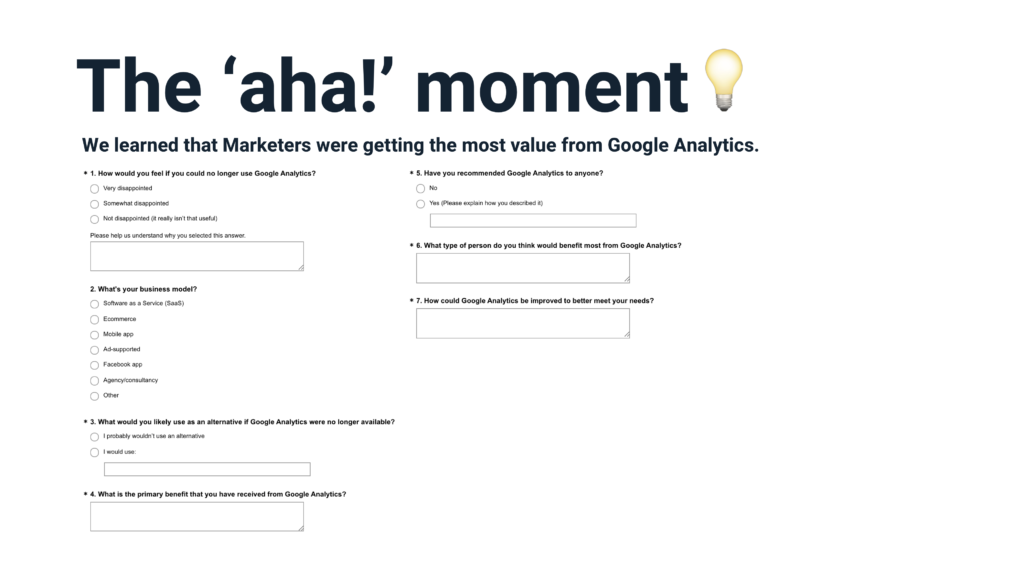
We learned that online marketers were getting the most value from Google Analytics and quickly found out that we should be targeting them. They needed data to help them improve the performance of marketing campaigns once people visited their websites. They were also willing to pay for analytics to help them improve website conversion rates.
At that point, we did everything right. Literally, everything.
We identified the burning problems people had and focused on a lucrative segment of the market, online marketers. And we built a product that addressed their problems.
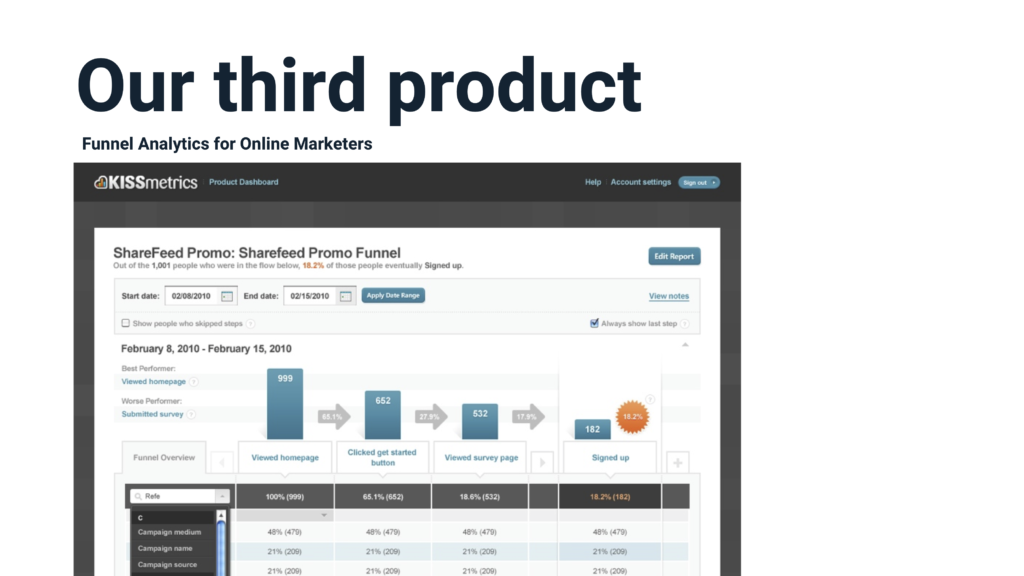
Not just that, we kept on building all the right things at lightning speed. We found and nailed every single customer need.
Take funnel reports for example. Before KISSmetrics, it took too much time for people to create and understand funnel reports. Our funnel reports became the industry standard that many analytics tools copied.

Implementing and debugging tracking of new data into analytics tools could take weeks. That’s why we built a debugger we called “KISSmetrics Live” to show developers the exact data they were passing into the tool in real-time.
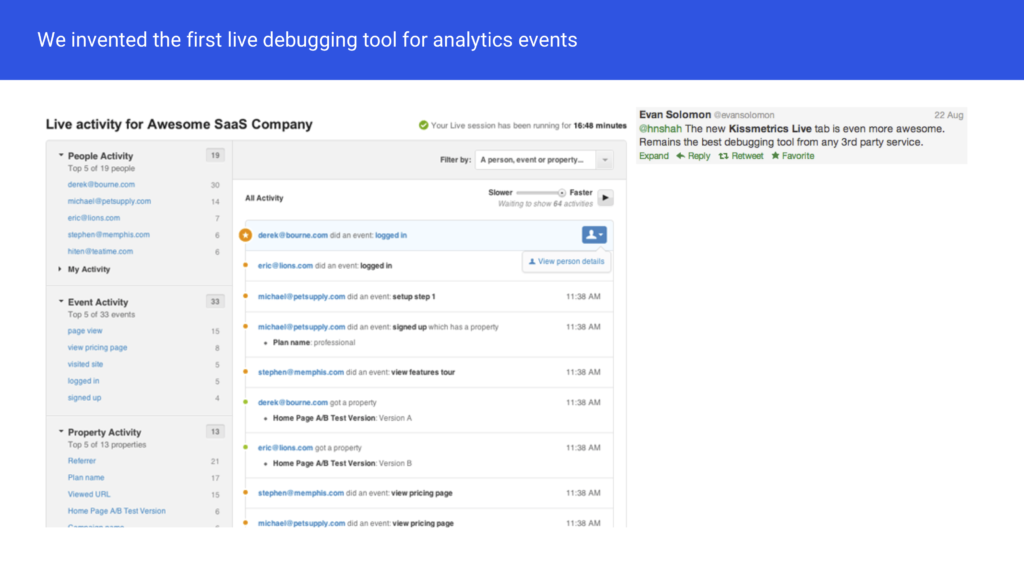
Passing user level data into analytics tools was impossible too. You weren’t able to see the users behind your data. So, we invented a new analytics data model. Every piece of data in KISSmetrics was tied to an identity, either an anonymous cookie or an email address.
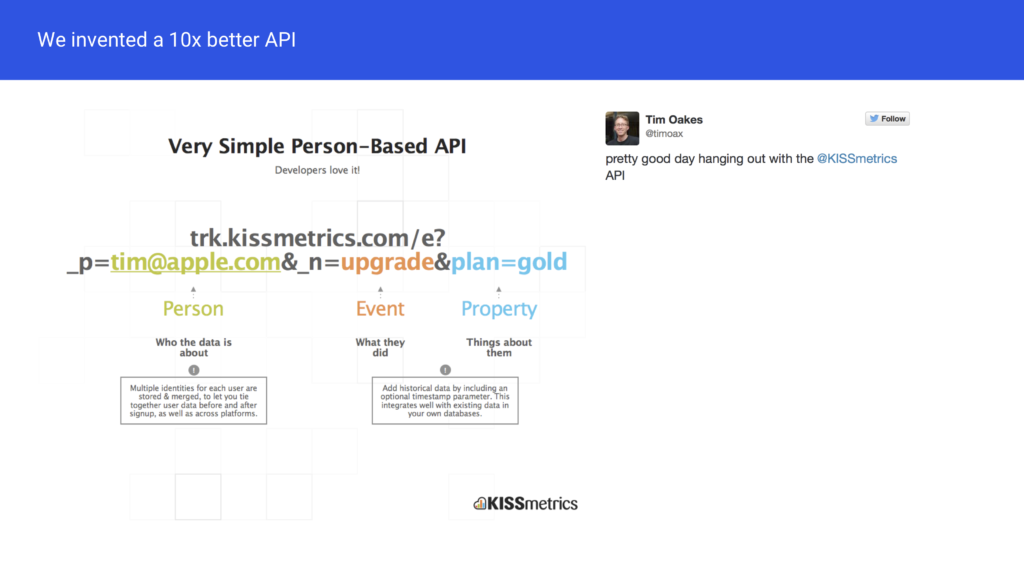
And we knew we had nailed it because customers couldn’t stop shouting from the rooftops (i.e. Twitter) about how useful our product was. We had nailed every pain point that people had and they were willing to tell their friends about it. At that time we were still in early access mode and were getting hundreds of new sign ups every week.

We were ahead of the market by 3 years. Yes, 3 full years. In 2010, we had moved the entire analytics category to the point that competitors wouldn’t close the gap until 2013.
We had a billion dollar opportunity sitting right in front of us. Without a shred of doubt, I believe we could have turned KISSmetrics into a billion dollar startup. It was ours to lose.
That’s exactly what we did, we lost it.
This failure was on me and me alone. *I* really screwed up. Big time.
I remember when it all started. My team would laugh at me. They’d crack jokes about me. Seriously, this would happen.
And it was my fault.
The Hiten Bomb
Every week. Actually, it was usually daily. I would drop a bomb on someone in the company. It would be some new idea, some new direction, some new brilliant thing I came up with. Something we absolutely had to do right now.
A new feature I thought would help us grow. (But really, it wouldn’t).
A competitor-inspired idea. (A feature that wasn’t actually game changing).
Something I had heard from an investor, advisor or friend. (And it seemed really cool at the time, I swear… but still, worthless).
At best, it was an idea I had gotten from an important customer the day before.
This was constant. Went on for months. It got so bad that the jokes made their way to me. The whole company started calling them Hiten Bombs. I heard it in the halls and walking by people’s desks.
I didn’t realize it at the time, but to my team the barrage of random ideas seemed like they were coming completely out of left field.
Good or bad, none of my ideas were based on any kind of framework or filter. I was shooting from the hip. Thinking that I was helping us focus and execute.
I was dead wrong.
Every time that I threw a “Hiten Bomb”, things actually blew up.
The team would rush to execute on my idea. Whatever I wanted to do became a priority. They’d huddle together to figure out the best and fastest way to accomplish the thing I had mentioned. They’d pull in more teammates and add it to our growing list of competing features to build, bugs to fix and customer requests.
Worse yet, after a few really messy, disruptive “Hiten Bombs” that didn’t actually move the needle, the team stopped listening to me. Eventually they lost confidence in me as a leader and even the overall strategy of the company.
I was setting a bad example but expecting stellar results from my team. I wanted them to be doing customer research, digging into our data and using all that information to build the features that actually mattered.
Instead I was making the situation worse, not better.
First my team started to cope in subtle ways.
“Hiten’s got yet another *great* idea that’ll save the company.”
“I’m going to wait till I hear it from him three times before I do anything about it.”
“I just had another Hiten Bomb dropped on me. I ignored it.”
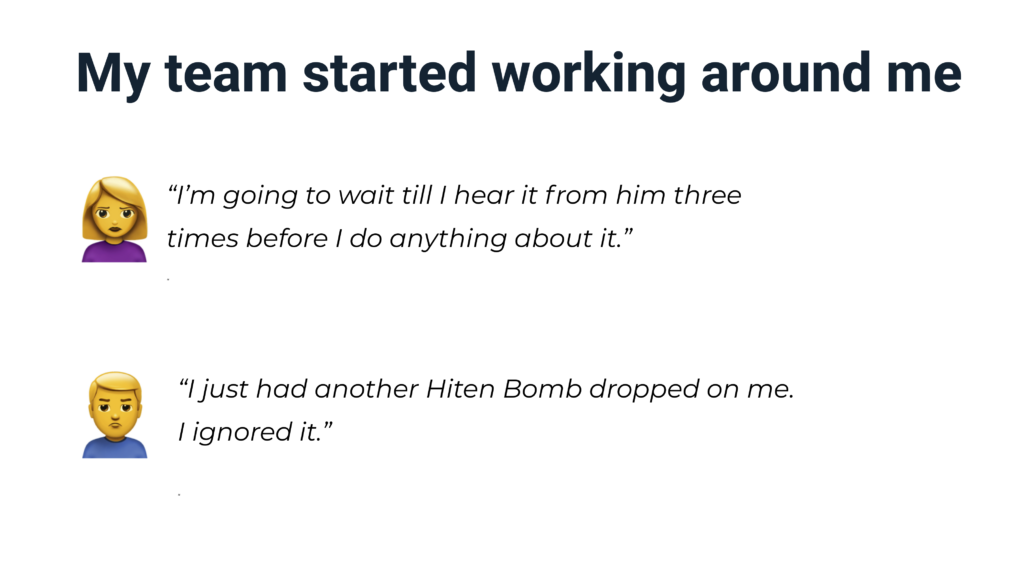
Then it happened. Our head of product wrote an internal memo to the whole company where he described exactly what a Hiten Bomb was and how it was impacting the team.
“Hopefully I can help everyone understand where those things that might seem like left field are coming from.”
People had to explain and excuse my behavior. In reality, there wasn’t an excuse for what I was doing.
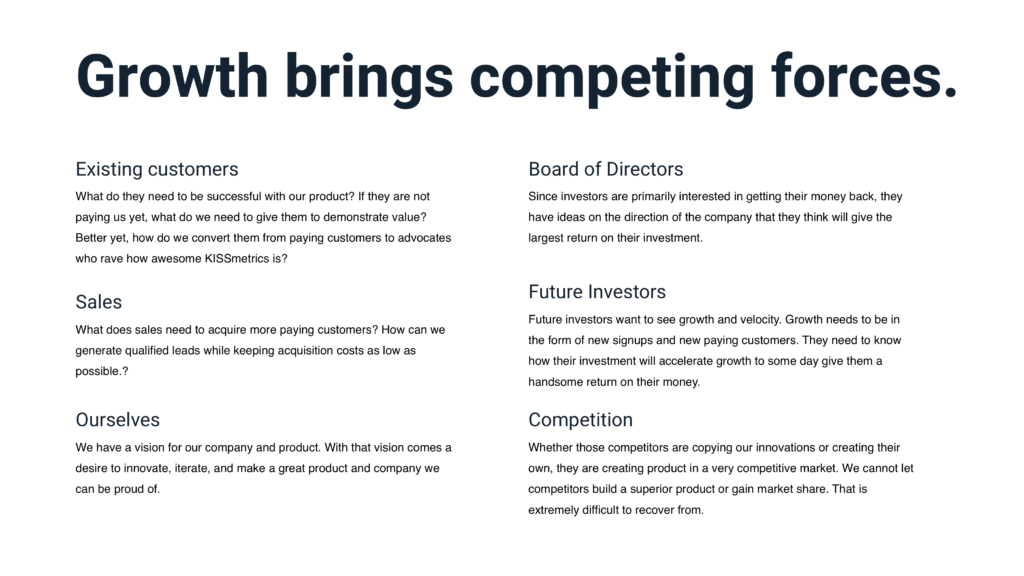
After the memo went out to the team, I stopped. If someone on the team had to write a 1300 word memo about my drive-by management style, I was the problem. Not them.
I was holding the company back.
That’s what it took for me to change. Months and months of frustrated team members, countless wasted hours working on things that didn’t matter, competitors getting ahead and customers leaving us for them as a result.
We had all the right inputs, we had the right intention. What we didn’t have was a process to prioritize what we worked on and why.
We were scattered. Every single person on the team was doing whatever they thought was right without knowing what was best for the business.
I myself didn’t know what to do and which inputs to pay attention to. After months of this and because of the memo, I found out that this was exactly how the team felt too.
And I was making it worse.
That’s not what a great leader does. They don’t distract the team. They don’t make everyday feel like a new set of fire drills. They don’t send mixed messages about what needs to be done.
They don’t constantly drop “Hiten Bombs” on the team, like I was.
Great leaders are consistent, they help provide a direction and get the team focused on doing what’s best for the business, at all times.
They are unbiased, focused on execution, developing a vision, helping prioritize and getting alignment from the team. That’s also what a great product manager does every day.
That’s what you need to do every day.
As a product leader or manager, nothing else matters.
Your job is to filter all the inputs coming at you every day. Remove all the distractions. Decide where to focus limited resources. Determine the right activities that will actually move the needle forward for your business. With everyone aligned so only the most important priorities get executed.
What happens if you don’t?
At best, you’ll lose the faith of your team. They’ll start leaving a little earlier each day, start dragging their feet a little longer on each product. They won’t trust you like they did originally. You’ll have burned them with too many dead-ends or too much drive-by management.
At worst, you’ll stall your product momentum and leave yourself wide open for a competitor to grow right past you. Believe me, it will happen. Even with a 3 year head start on an entire category, our competitors still closed the gap on us at KISSmetrics.
How Our Competitors Closed Our Lead and Sped Past Us
Because we were so distracted by Hiten bombs, we underestimated the impact of competitors. Competitors who successfully started to cannibalize the market. They built faster than us, copying every piece of what we did, since we had gotten it right. And then they made incremental improvements and targeted different up-and-coming customers that we missed.
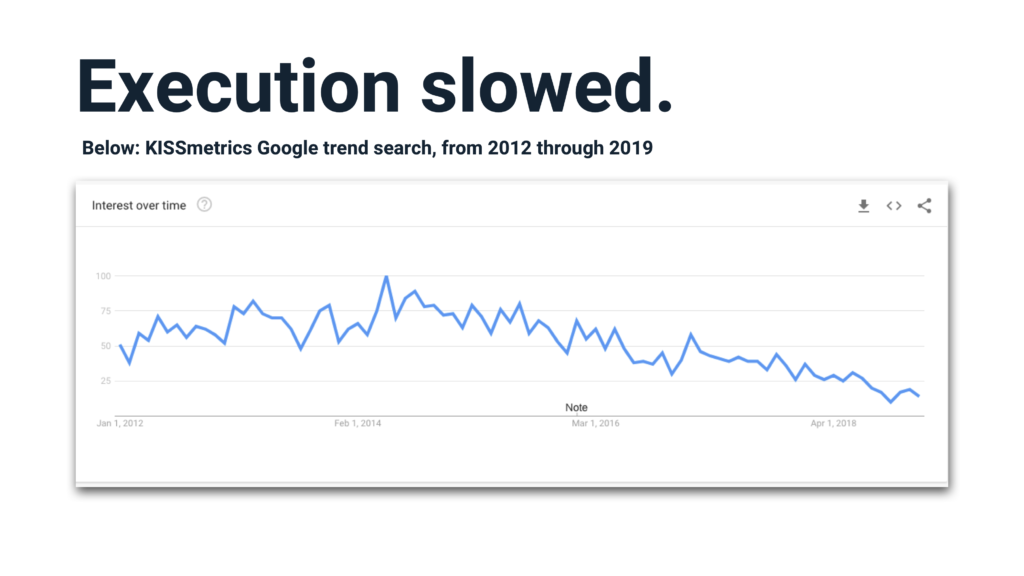
Our product was web-focused and they quickly focused on mobile apps. Even to this day, KISSmetrics still doesn’t work well for mobile apps. One of our more nimble and fast following competitors beat us to the punch. Mixpanel started to focus on mobile apps long before we were even thinking about it.
This shift in focus helped them raise $77 million in funding. In comparison, we raised less than $25 million at KISSmetrics.
Mixpanel also had a free plan (KISSmetrics didn’t) and a way for people to track even more data for free by installing a badge on their website.
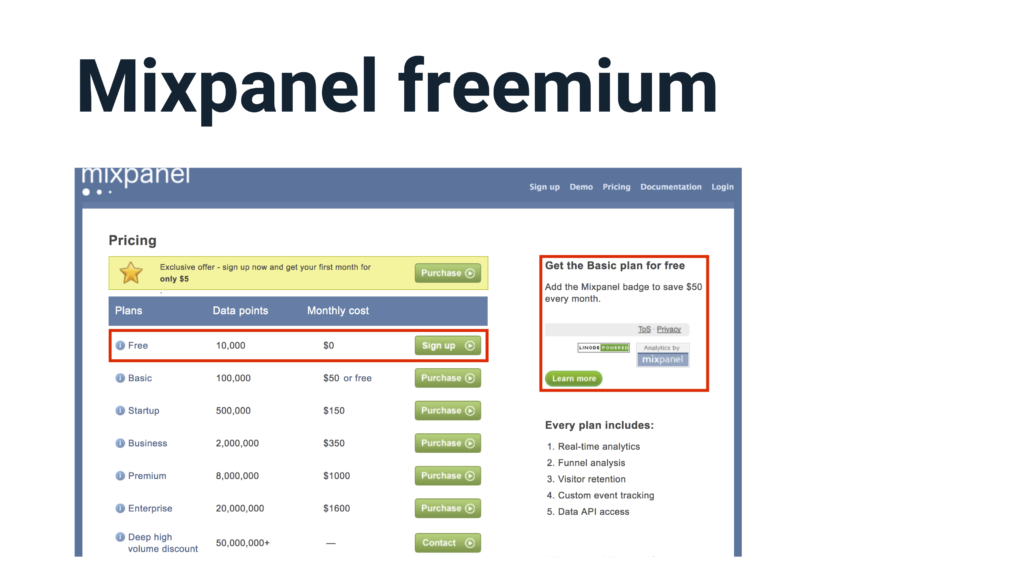
We just brushed their strategy off because we thought it would be expensive for us to do. We assumed the customer support and infrastructure costs would be too high for us to provide something similar. We should have copied Mixpanel’s strategy as soon as we saw the site badges in the wild.
We were first to create a real-time tracking debugger in the analytics space. It was designed to help people implement and debug their data. But we missed one big thing: eye candy.
The real-time view looks really cool when it’s left open and you can watch it. Mixpanel realized this feature helped them close deals. They hyped it up during sales demos much more than we did. They also improved it so it had more eye candy than ours. We ignored what they did, didn’t think about the “why” behind it, and lost a ton of sales.
A new competitor called Heap came into the space even later than Mixpanel. They had a very strong value proposition by having a simple API to implement analytics tracking. They enabled people to install a single tracking script once and track every single thing people did on a website automatically.
When they first started we could have easily copied the feature and destroyed their momentum. We didn’t. They now have over 6,000 customers and have raised a total of $40 million.
These were just a few instances when competitor ignorance and poor execution really hurt us.
We were actually great at coming up with the right ideas and instead of executing (and iterating) fast on them, we watched others come up with them later and execute much faster. Or we arrogantly brushed off ideas that the market desperately wanted, leaving the opportunity wide open for our competitors.
We missed the boat on so so many great opportunities to make customers love us even more.
We ignored competitors instead of learning from their moves to evolve our market hypothesis. We didn’t prioritize our product development with the right data. We were missing critical pieces of information because, instead of looking at competitors to understand our customers better, we completely ignored them.
The Root Cause
First, we struggled during year one of KISSmetrics. We kept trying different ideas and nothing worked.
Then, out of desperation, we tried an entirely different approach to product. We talked to customers, we identified the biggest opportunities, we listened to the market. We didn’t have a reliable process at this point, we just knew we had to do something different. We stumbled into a process that built a true hit product.
Two years later, we had built an MVP that was on fire. We couldn’t keep track of all the word-of-mouth and the tweets of joy on Twitter.
And then we began to slip.
A few years into our business, our execution slowed.
We were no longer innovating and staying ahead of the curve. We grew the team but we slowed down how quickly we could build. It was a matter of time before competitors would get ahead. Eventually, they did pull ahead.
They will copy what you have and will push past you. If their team is great at copying, their innovation abilities probably won’t be as good. But any improvements they make on even just a single piece of what you’ve invented will help them pull ahead. They just have to be a little faster and improve better than you.
Speed really does matter.
You can’t just capture the market once and expect to keep it. You have to do it over and over again and faster than everyone else if you want to keep distance from competitors coming up behind you and disrupting you. That’s how you get ahead of the market.
Finally, we lost that magic. We forgot the process that helped us deliver that initial amazing product. We went back to old, bad habits. And we stalled our progress on product for 3 years, enough time for the rest of the industry to catch up and then innovate past us.
All because we lost sight of how we produced that initial success.
We lost out on a billion-dollar opportunity by not doing the right things after our initial success.
Don’t make the same mistakes I did.
It’s too easy to build from the hip or rely on consensus when creating a product. I’ve learned that the key to driving growth on product is to create product processes that produce repeatable wins. Not one win, not two wins. But wins that can take you through months, years, even decades.
The winning product process is based on continuous innovation. It’s based on focus and planning. Continuous unbiased research and goal-focused development. Building product the right way takes work up front, but if you put in the work, you’ll be rewarded each and every time you sit down and look at your metrics.
